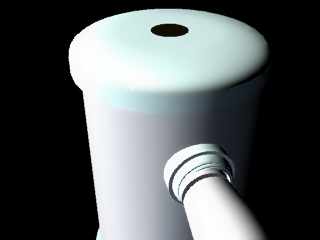|
Space Science Laboratory

Function:
To conduct physics and chemistry experiments
To observe space - Sun, Moon, Planets, Stars, Comets, Asteroids, and Radiation

A New Environment to Explore - Physics and Chemistry in Space
In
space we enter a new and unfamilar realm. The first thing you
notice is that you are weightless. You float about in the air!
You are in conditions scientists call microgravity, because although
you cannot feel or directly see the effects because it is so small,
gravity is stll working here. It is the gravity that is produced
by the objects around you, and of course you, yourself. A fuller
explanation of Gravity is given in Newton's
Motions.
The other thing you will have noticed is that you can't go outside. Not without putting on a space suit, anyway! There are several reasons for this. First there is no air to breathe out there, secondly you will get very hot, very quickly if you are in the sunshine or very cold, very quickly if you are in the shadow of the Earth. Your suit has an environmental system to keep you comfortable.
Space also offers no protection from radiation. Radiation comes in many forms heat, light, radiowave, microwaves and X-rays to mention just a few. Some forms can be harmful to you, and in space the radiation is strong. You need protection, and once again your suit gives you this.
As you may have realised now, the space environment is very different from that on the planet and we can investigate it using both physics and chemistry. To sum up the main differences are:
- Microgravity
- Vacuum
- Strong Radiation
- Solar Heating
We can take advantage of these free environments for our experiments and perhaps we will make new discoveries.

A New View on the Universe
The other advantage in being in space is that the view of the sky is much better than on Earth. The space station is about 400 km (250 miles) above the surface of the Earth, and therefore above the atmosphere. Viewing other planets, stars and galaxies from the space station with both optical and radio, X-ray, and infra-red telescopes is going to be much easier here. Instruments such as these may be mounted on a free-flying platform, nearby, so that they are not affected by the vibration of the rest of the space station. The Hubble Space Telescope has already increased our knowledge of the universe by sending back high-quality images that would never have been possible from even the highest observatory on Earth. The water vapour and gas in the Earth's atmosphere tend to scatter incoming light to the telescope, and what's more the air is constantly moving. This is what makes stars twinkle.

Project:
Observe the Space Station
While you can't look down from the Space Station you can look up at the ISS. Did you know, you can see space stations and satellites cross the sky at night when it is clear?
The best time is in the hours after sunset, when you are in the dark, but the spacecraft are still in the light and catch reflected sunshine. They show up as bright points of light, often brighter than stars and of course, they move. They are slower than aircraft and do not have flashing coloured lights.
NASA now has a site where you can find out the next time the International Space Station will pass over your head. It is at: Human Spaceflight - Realtime Data
Another project you should look out for, and one you can take part in yourself is Starshine. It is a satellite that was launched from a Shuttle flight . Go to the Starshine website at: Project Starshine
You can try photographing satellites and the ISS at night. When it is clear, set up you camera on a tripod, face the lens into the sky where the satellite or space station is located or expected and hold the shutter open for a few seconds when it comes into view. You will get a trail on the image. Visit the SEDS site to see an image of Mir, closely followed by a Progress supply module: SEDS, Photographing Mir Page

For
an introduction to what you can see in the sky go to Newton's
Motions.

Go
to Space Station 2020 Specification
Return
to title page

|













